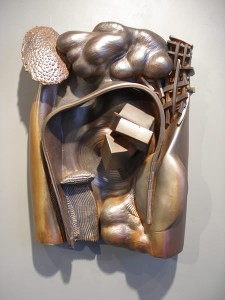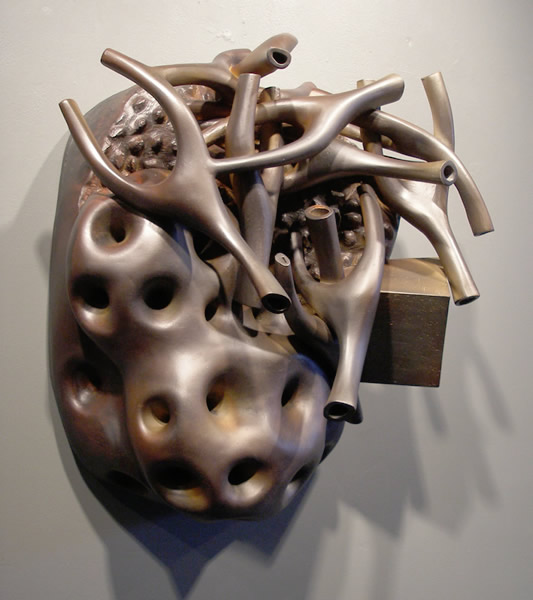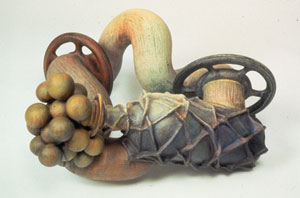I
IMAGES: SYD CARPENTER Google Images
LINK: Swarthmore College
VIDEOS:
- You Tube Video – A Place of her Own http://www.youtube.com/watch?v=0NHYWZ713dA 8 minutes long – Description of Garden Work
- Vimeo — Syd Carpenter http://vimeo.com/36736786 54 minutes long…. Good Slide Lecture at UArts
- African American Farms and Gardens by syd carpenter
BIO/CV
Born 1953
She received both her B.F.A. and her M.F.A. from Tyler School of Art in 1974 and 1976, respectively. Among the numerous awards she has received are a Mid Atlantic Arts Foundation National Endowment for the Arts Regional Fellowship, two Pennsylvania Council on the Arts Visual Arts Fellowships, and an Awards in the Visual Arts Fellowship. She currently teaches at Swarthmore College. PEW Fellowship Awardee 1992
Syd Carpenter’s work is in the collection of the Philadelphia Museum of Art, Atlantic Richfield Corporation, Nabisco Brands, the University of Illinois, Art in General, New York, Philadelphia Convention Center, Bell Atlantic Corporation, Canton Ohio Museum of Art, Erie Museum of Art, Renwick Gallery of the Smithsonian Institute, Jingdezhen Ceramic Institute, Jingdezhen China, and in numerous private collections.
ARTIST STATEMENT
Working as an artist has been the source of all that has been meaningful and a source of joy in my life. Art is my common ground around which revolves my interaction with family, teaching and community. The enthusiasm and commitment I bring to my teaching is an outcome of the level to which I am engaged in my art while community involvement allows me to share the value I place on the visual with those who may otherwise disregard its impact upon their lives. Family is a constant source of inspiration both as image and encouragement. I don’t believe artists make the decision to become artists. They are born. The hope is that they find the will to pursue their vision, an environment in which to develop, and a culture respectful of their contributions.
When you leave an exhibit of Syd Carpenter’s work, you want to leave the lights on and make sure that each piece has ample water. Her painted ceramic sculptures relentlessly sprout heads, wheels, or nest-like tangles of netted clay. Shoots reach for soil or water, or perhaps they draw sustenance from the air itself. The explosive proliferation of elements seems to want to continue independently of the viewer and in his absence. Ms. Carpenter’s fertile combinations and re-combinations of images have an almost grammatical logic, but the reappearance of a motif like a bottle or a wheel seems more the result of an intuitive, emotional decision than a conscious narration.
Art Statement –A Place Of Our Own, Mar 2010
Andrew and Magnolia Moses, James and Mary Miller, Juanita and Fox Fleming tend farms and gardens in rural southern states. They and several other gardeners were the subject of a study of African American farms ways conducted in the late 80’s by landscape architect Richard Westmacott. In his study , Westmacott meticulously mapped each farm and it is these maps that provide the source for my sculptures.
As a gardener myself, the discovery of this study of African American gardeners was revelatory. The gardeners described their relationship to their spaces and the sense of independence derived from providing for themselves and their communities. The farms are a lesson in resourceful ingenuity and pragmatic beauty. As fewer and fewer African Americans remain on the land as farmers, their testimony to the value of their way of life appealed to that part of me that also needs the garden as physical and spiritual sustenance. Westmacott’s maps documented the location of buildings, roads, fields, trees and animal pens. In response I began building the maps, seeing flattened shapes in three dimensions and ultimately digressing from the maps to create my own imagined landscaped farms and gardens.
Syd Carpenter Turns Clay Back Into Earth At Sande Webster
Roberta Fallon Philadelphia Art Blog
In the 1980’s Richard Westmacott, landscape architect and professor emeritus at the University of Georgia, conducted a study of African American farms and gardens, mapping out each farm in order to understand cultural relationships to building, growing, and earth. Syd Carpenter used Westmacott’s meticulous documentation as a starting point for her sculptural ceramics show A Place of Our Own at Sande Webster Gallery. These pieces couldn’t be more different from the work at Locks-while they have the medium of clay in common, all other aspects of the work vary from the tradition of brightly colored vessels. Carpenter’s sculptures are abstracted land portraits, telling a story about the daily lives lived in these particular spaces.
The clay medium undulates into walls and earth, weather and crops reflecting the gallery lights in a way that implies the harsh sun beating down on a shed roof. Many pieces use walls, fences, and land masses to create a sense of containment that sometimes reads as ownership and other times looks claustrophobic.
Carpenter interjects mundane objects like clothes pins, fence posts, and wish bones into the landscape magnifying their importance through scale. Standing among the 14 sculptures it seemed as though all aspects of farm life were there from belonging and communion with the earth to the feeling that everything is folding in and crushing you. While some seemed orderly and manageable, a piece like Inez Faust, with its undulating heart shape and pile of giant wishbones almost cantilevering off the wall, really communicates a feeling of precariousness, difficulty, and a the heavy burden of hope.
Carpenter’s Remedy; Other Works In Clay
By libby | April 16, 2005
“Syd Carpenter: Remedy” at Sande Webster had me wondering just which cure Carpenter was seeking. Remedy for what? But Carpenter is never to be taken lightly. Her clay sculptures continue to raise issues-and not give answers-about race and life and memory and magic and always about people (left, “Frank Persists,” a sort of wheeled pull toy with a bobbly bird at the bottom and Frank in a hat at the top).
The sculptures on the wall are medicinal, with a suggestion of the power of roots and plants and old-fashioned extracts and tonics. Giant talismans of primitive powers, they merge bottles with hanks of hair, vines and other plant forms, muscled limbs, medical instruments, pacifiers, toys, bandages to offer remedies to whatever ails, be it spiritual or physical woes.
These wall pieces, anywhere from about 3 1/2 to 5 feet long, are often funny, with comic-book rubbery exaggeration of shapes-petals that look like ears, corks or plugs that look like ear plugs-and suprising, sometimes unsettling juxtapositions of forms. Give these sticks to your neighborhood shaman and let him try to shake them for good luck (right, “Blood Ties”). The humor offers a kind of perspective-the ability to survive through personal strength and humor. The twisting forms call up the healing powers of nature-and magic. I have no clue whether the survival here is literal or metaphoric, but it works either way.
While the wall pieces and one of the pedestal sculptures use a vocabulary of shapes that are close to past work from Carpenter, the other pedestal pieces are new work-a merger of sexy body shapes-hips and haunches, legs, breasts, etc.-and leaves or petals. They look like upside-down tulips. But the surfaces suggest unevenly pigmented skin-and the merger of more than one tone of flesh with another. The humor here is gone, but the clay made flesh calls out for caresses. And once again the material, the clay, with all its fragility and strength, communicates with the subject matter (left, “Remedy”).
Carpenter’s Tools
By roberta | April 22, 2005
I met Syd Carpenter at Sande Webster Gallery last Saturday for an interview. It was a great chance for me to catch up with the diminutive clay sculptor whom I hadn’t seen since I met with her and New Orleans-based ceramic artist MaPo Kinnord-Payton at Swarthmore in 2003. I wrote a story for PW about Kinnord-Payton and a project she is involved with in Ghana. I’ll chase down that link later. Here I want to run some pictures and encourage you to get out and see the show, which is up to April 29.
A show of Carpenter’s new works is always an event. The artist is always thinking her way to new ideas and pushing her work in new directions. The surprise in this show is the two bodies of work, — tool pieces and other works with sexy, animal-like shapes — which grew simultaneously, and which seem to complement each other like hand and glove (or hand and tool). Libby wrote about the show in her post.
Everything is an implement here. Medical implement; plant implement; human implement. Carpenter, who is very tiny, works without an assistant. She said the work is never bigger than her — that is one frame of reference on scale. She has a studio with a kiln and fires the work, sometimes three or four times before it’s “right.” Sometimes she couples this and that to make a work, sawing the clay and glueing it together. She paints the surface if she feels it’s warranted. This body of work had less paint and more pure clay glaze finishes, she said.
The show represents less than a year’s worth of work. Carpenter has been on sabbatical from Swarthmore this year and the work poured out of her after she spent a month in Ghana with MaPo working in a remote village helping construct housing that had been washed away. They got a master kiln builder to come and build a kiln in the village. Apparently it was an intense experience.
Carpenter told me she’s having a solo exhibit at Delaware Center for Contemporary Art in 2006. Her husband, Steve Donegan, had a show there a while back and she was impressed with the space.
Of the organic animal/plant forms that sit on the specially-made tables Carpenter said the work came out of looking at leaves and how they twist and turn and rest on their points and stems like dancers balancing in the most delicate and refined ways. But when she started working, her brain and hand transformed the leaf forms into something more animal-like and well that’s part of the process too, where your mind and where the materials take you.





